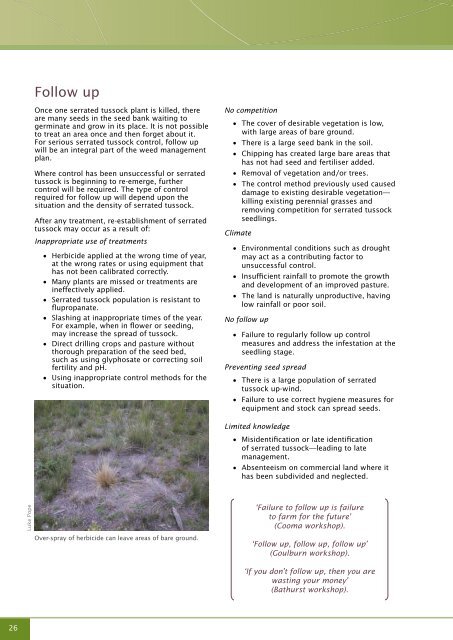Section 2 Integrated weed management (IWM) - Weeds Australia
Section 2 Integrated weed management (IWM) - Weeds Australia
Section 2 Integrated weed management (IWM) - Weeds Australia
You also want an ePaper? Increase the reach of your titles
YUMPU automatically turns print PDFs into web optimized ePapers that Google loves.
Follow upOnce one serrated tussock plant is killed, thereare many seeds in the seed bank waiting togerminate and grow in its place. It is not possibleto treat an area once and then forget about it.For serious serrated tussock control, follow upwill be an integral part of the <strong>weed</strong> <strong>management</strong>plan.Where control has been unsuccessful or serratedtussock is beginning to re-emerge, furthercontrol will be required. The type of controlrequired for follow up will depend upon thesituation and the density of serrated tussock.After any treatment, re-establishment of serratedtussock may occur as a result of:Inappropriate use of treatments• Herbicide applied at the wrong time of year,at the wrong rates or using equipment thathas not been calibrated correctly.• Many plants are missed or treatments areineffectively applied.• Serrated tussock population is resistant toflupropanate.• Slashing at inappropriate times of the year.For example, when in flower or seeding,may increase the spread of tussock.• Direct drilling crops and pasture withoutthorough preparation of the seed bed,such as using glyphosate or correcting soilfertility and pH.• Using inappropriate control methods for thesituation.No competition• The cover of desirable vegetation is low,with large areas of bare ground.• There is a large seed bank in the soil.• Chipping has created large bare areas thathas not had seed and fertiliser added.• Removal of vegetation and/or trees.• The control method previously used causeddamage to existing desirable vegetation—killing existing perennial grasses andremoving competition for serrated tussockseedlings.Climate• Environmental conditions such as droughtmay act as a contributing factor tounsuccessful control.• Insufficient rainfall to promote the growthand development of an improved pasture.• The land is naturally unproductive, havinglow rainfall or poor soil.No follow up• Failure to regularly follow up controlmeasures and address the infestation at theseedling stage.Preventing seed spread• There is a large population of serratedtussock up-wind.• Failure to use correct hygiene measures forequipment and stock can spread seeds.Limited knowledge• Misidentification or late identificationof serrated tussock—leading to late<strong>management</strong>.• Absenteeism on commercial land where ithas been subdivided and neglected.Luke PopeOver-spray of herbicide can leave areas of bare ground.‘Failure to follow up is failureto farm for the future’(Cooma workshop).‘Follow up, follow up, follow up’(Goulburn workshop).‘If you don’t follow up, then you arewasting your money’(Bathurst workshop).26

















